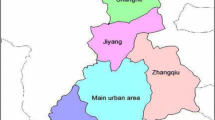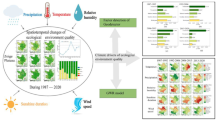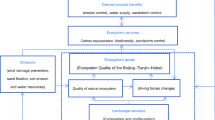Abstract
Environmental degradation is a global ecological concern, and land use transitions play a critical role in a region’s ecological well-being and long-term sustainability. In this paper, indicators related to land use transitions, including the regional eco-environmental quality index (EV), the remote sensing ecological index (RSEI), and soil erosion, are selected to analyze the eco-environmental quality of Erhai Lake Basin from 2000 to 2020. The results showed that (1) from 2000 to 2020, forestland, grassland, and cultivated land were the major land use types in the study region, and also the land use types where land use transition was notable; (2) over the 20 years of study, the EV value of Erhai Lake Basin increased by 0.003, its average RSEI increased by 0.14, and the average soil erosion modulus there decreased by 15.48 t/(km2·a), indicating that the eco-environment of the Erhai Lake Basin was improving. Evaluation based on multiple ecological indicators was superior to assessment relying on single indicators; (3) all three ecological indicators showed that the ecological environment of the basin was improving, but with significant regional differences. Forestland had the best ecological quality, while unused land and built-up land had the worst. RSEI was more regionally adaptable than the other two indices. (4) The transition of cultivated land into other land use types was the main reason for the improved ecological quality in the basin, while tourism had accelerated land use transformation. Compared with assessment based on single ecological indicators, evaluation based on a combination of multiple ecological indicators can more accurately reflect the ecological condition of the study area and provide a basis for eco-environmental protection in Erhai Lake Basin.








Similar content being viewed by others
Data availability
All data generated or analyzed during this study are included in this published article.
References
Aksoy H, Kaptan S, Varol T, Cetin M, Ozel HB (2022a) Exploring land use/land cover change by using density analysis method in yenice. Int J Environ Sci Technol (tehran): 1–18. https://doi.org/10.1007/s13762-021-03847-5
Aksoy T, Dabanli A, Cetin M, Senyel Kurkcuoglu MA, Cengiz AE, Cabuk SN, Agacsapan B, Cabuk A (2022b) Evaluation of comparing urban area land use change with Urban Atlas and CORINE data. Environ Sci Pollut Res 29:28995–29015. https://doi.org/10.1007/s11356-021-17766-y
Ashraf M, Ullah K, Adnan S (2022) Satellite based impact assessment of temperature and rainfall variability on drought indices in Southern Pakistan. IJAEO 108:102726. https://doi.org/10.1016/j.jag.2022.102726
Biswas A, Gangwar D (2021) Studying the water crisis in Delhi due to rapid urbanisation and land use transformation. Int J Urb Sus Dev 13:199–213. https://doi.org/10.1080/19463138.2020.1858423
Boori MS, Choudhary K, Paringer R, Kupriyanov A (2021) Eco-environmental quality assessment based on pressure-state-response framework by remote sensing and GIS. Remote Sens App: Soc Env 23:100530. https://doi.org/10.1016/j.rsase.2021.100530
Cetin M (2015) Evaluation of the sustainable tourism potential of a protected area for landscape planning: a case study of the ancient city of Pompeipolis in Kastamonu. Int J Sustain Dev World Ecol 22(6):490–495. https://doi.org/10.1080/13504509.2015.1081651
Cetin M (2019) The effect of urban planning on urban formations determining bioclimatic comfort area’s effect using satellitia imagines on air quality: a case study of Bursa city. Air Qual Atmos Health 12(10):1237–1249. https://doi.org/10.1007/s11869-019-00742-4
Cetin M (2020) Climate comfort depending on different altitudes and land use in the urban areas in Kahramanmaras City. Air Qual Atmos Health 13(8):991–999. https://doi.org/10.1007/s11869-020-00858-y
Chang Y, Hou K, Wu Y, Li X, Zhang J (2019) A conceptual framework for establishing the index system of ecological environment evaluation–a case study of the upper Hanjiang River, China. Ecol Indic 107:105568. https://doi.org/10.1016/j.ecolind.2019.105568
Chen J, Wu C (2020) Evaluation of ecological sensitivity in Erhai Lake Basin, southwest China. IOP Conf Ser Earth Environ Sci 612:012072. https://doi.org/10.1088/1755-1315/612/1/012072
Chen Q, Wang S, Ni Z, Guo Y, Liu X, Wang G, Li H (2021) No-linear dynamics of lake ecosystem in responding to changes of nutrient regimes and climate factors: case study on Dianchi and Erhai lakes. China Scten 781:146761. https://doi.org/10.1016/j.scitotenv.2021.146761
Cui X, Liu C, Shan L, Lin J, Zhang J, Jiang Y, Zhang G (2022) Spatial-temporal responses of ecosystem services to land use transformation driven by rapid urbanization: a case study of Hubei province, China. Int J Env Res Public Health 19(1):178. https://doi.org/10.3390/ijerph19010178
Diao J, Liu J, Zhu Z, Li M, Sleeter BM (2020) Substantially greater carbon emissions estimated based on annual land-use transition data. Remote Sen 12(7):1126. https://doi.org/10.3390/rs12071126
Dong X, Feng Y, Le Y, Yuyu Z, Haixing L, Jinji M, Jincai H, Jing W, Yang X, Chong Z, Jie C (2021) Quantization of the coupling mechanism between eco-environmental quality and urbanization from multisource remote sensing data. J Clean Prod 321:128948. https://doi.org/10.1016/j.jclepro.2021.128948
Du X, Huang Z (2017) Ecological and environmental effects of land use change in rapid urbanization: the case of Hangzhou, China. Ecol Indicators 81:243–251. https://doi.org/10.1016/j.ecolind.2017.05.040
Gou M, Liu C, Li L, Xiao W, Wang N, Hu J (2021) Ecosystem service value effects of the Three Gorges Reservoir Area land use transformation under the perspective of “production-living-ecological” space. J Appl Ecol 32(11):3933–3941. https://doi.org/10.13287/j.1001-9332.202111.020
Guo L, Liu R, Men C, Wang Q, Miao Y, Shoaib M, Wang Y, Jiao L, Zhang Y (2021) Multiscale spatiotemporal characteristics of landscape patterns, hotspots, and influencing factors for soil erosion. ScTEn 779:146474. https://doi.org/10.1016/j.scitotenv.2021.146474
Hu P, Li F, Sun X, Liu Y, Chen X, Hu D (2021) Assessment of land-use/cover changes and its ecological effect in rapidly urbanized areas—taking Pearl River Delta urban agglomeration as a case. Sustainability 13(9):5075. https://doi.org/10.3390/su13095075
Ji J, Wang S, Zhou Y, Liu W, Wang L (2020) Spatiotemporal change and landscape pattern variation of eco-environmental quality in Jing-Jin-Ji urban agglomeration from 2001 to 2015. IEEE Access 8:125535–125548. https://doi.org/10.1109/ACCESS.2020.3007786
Jin G, Deng X, Yuan Y, Ma S, Li Z, Shi S (2017) Scenario simulation of land exploitation and risk assessment of soil erosion in the low-slope hilly area of the Erhai basin. Phys Chem Earth Parts a/b/c 101:78–85. https://doi.org/10.1016/j.pce.2017.01.020
Johannes S, Paul O, Gideon W (2022) Assessing the adverse effects of land use activities on the water quality of selected Sub-Saharan Africa Reservoirs using a combination of water quality indices. Water Air Soil Pollut 233(7):1–19. https://doi.org/10.1007/s11270-022-05703-9
Ju Z, Wen A, Yan D, Shi C (2015) Estimation of soil erosion in small watershed of the Three Gorges Reservoir region based on GIS and RUSLE. Earth Environ 43(7):331–337. https://doi.org/10.14050/j.cnki.1672-9250.2015.03.010
Kabir U, Mir AM, Sajana M (2018) Assessment of land cover change and its impact on changes in soil erosion risk in Nepal. Sustainability 10(12):4715. https://doi.org/10.3390/su10124715
Kalayci Onac A, Cetin M, Sevik H, Orman P, Karci A, Gonullu Sutcuoglu G (2021) Rethinking the campus transportation network in the scope of ecological design principles: case study of Izmir Katip Çelebi University Çiğli Campus. Environ Sci Pollut Res 28(36):50847–50866. https://doi.org/10.1007/s11356-021-14299-2
Kaya E, Agca M, Adiguzel F, Cetin M (2019) Spatial data analysis with R programming for environment. Hum Ecol Risk Assess 25(6):1521–1530. https://doi.org/10.1080/10807039.2018.1470896
Kilicoglu C, Cetin M, Aricak B, Sevik H (2020) Site selection by using the multi-criteria technique-a case study of Bafra, Turkey. Environ Monit Assess 192(9):1–12. https://doi.org/10.1007/s10661-020-08562-1
Li C, Wu J (2022) Land use transformation and eco-environmental effects based on production-living-ecological spatial synergy: evidence from Shaanxi Province, China. Environ Sci Pollut Res 29(27):41492–41504. https://doi.org/10.1007/s11356-022-18777-z
Li X, Fang C, Huang J, Mao H (2003) The urban land use transformations and associated effects on eco-environment in northwest China arid region: a case study in hexi region Gansu Province. Quat Sci 3:280–290+348-349. https://doi.org/10.3321/j.issn:1001-7410.2003.03.006
Li J, Bai Y, Alatalo JM (2020a) Impacts of rural tourism-driven land use change on ecosystems services provision in Erhai Lake Basin. China Ecosyst Serv 42:101081. https://doi.org/10.1016/j.ecoser.2020.101081
Li N, Wang J, Qin F (2020b) The improvement of ecological environment index model RSEI. Arabian J Geosci 13:403. https://doi.org/10.1007/s12517-020-05414-7
Li J, Zhou Y, Li Q, Yi S, Peng L (2022) Exploring the effects of land use changes on the landscape pattern and soil erosion of Western Hubei Province from 2000 to 2020. Int J Env Res Public Health 19(3):1571. https://doi.org/10.3390/ijerph19031571
Liang T, Yang F, Huang D, Luo Y, Wu Y, Wen C (2022) Land-use transformation and landscape ecological risk assessment in the Three Gorges Reservoir region based on the “production–living–ecological space” Perspective. Land 11(8):1234. https://doi.org/10.3390/land11081234
Liu B, Tao H, Liu S, Yu H (2014a) Temporal and spatial variations of rainfall erosivity in China during 1960 to 2009. Geo Res 32:245–256. https://doi.org/10.11821/yj2013020005
Liu Y, Huang X, Yang H, Zhong T (2014b) Environmental effects of land-use/cover change caused by urbanization and policies in Southwest China Karst area – a case study of Guiyang. Habitat Int 44:339–348. https://doi.org/10.1016/j.habitatint.2014.07.009
Liu J, Xu J, Chen J, Hong X, Zhou M (2019) Spatio-temporal distribution characteristics of water quality in Miju River and Erhai Lake. J Coast Res 93:31–38. https://doi.org/10.2112/SI93-005.1
Liu Y, Zhang D, He K, Gao Q, Qin F (2021) Research on land use change and ecological environment effect based on remote sensing sensor technology. J Sens 2021:4351733. https://doi.org/10.1155/2021/4351733
Liu Y, Wu K, Cao H (2022) Land-use change and its driving factors in Henan province from 1995 to 2015. Arabian J Geosci 15:247. https://doi.org/10.1007/s12517-022-09509-1
Ren W, Zhang X, Shi Y (2021) Evaluation of ecological environment effect of villages land use and cover change: a case study of some villages in Yudian town, Guangshui city, Hubei Province. Land 10(3):251. https://doi.org/10.3390/land10030251
Song Y, Xue D, Dai L, Wang P, Huang X, Xia S (2020) Land cover change and eco-environmental quality response of different geomorphic units on the Chinese Loess Plateau. J Arid Land 12:29–43. https://doi.org/10.1007/s40333-019-0031-8
Sun R, Wu Z, Chen B, Yang C, Qi D, Lan G, Fraedrich K (2020) Effects of land-use change on eco-environmental quality in Hainan Island. China Ecol Indicators 109:105777. https://doi.org/10.1016/j.ecolind.2019.105777
Sun L, Yu Y, Gao Y, He J, Yu X, Malik I, Wistuba M, Yu R (2021) Remote sensing monitoring and evaluation of the temporal and spatial changes in the eco-environment of a typical arid land of the Tarim Basin in Western China. Land 10(8):868. https://doi.org/10.3390/land10080868
Tang Y, Yang Y, Xu H (2022) The impact of China carbon emission trading system on land use transition: a macroscopic economic perspective. Land 11(1):41. https://doi.org/10.3390/land11010041
Wang C, Qo J, Shao Y, Sun S, Xiao L, Guo J (2019) Ecological environment assessment based on land use simulation: a case study in the Heihe River Basin. ScTEn 697:133928. https://doi.org/10.1016/j.scitotenv.2019.133928
Wang X, Deng Y, Tuo Y, Cao R, Zhou Z, Xiao Y (2021) Study on the temporal and spatial distribution of chlorophyll a in Erhai Lake based on multispectral data from environmental satellites. Ecol Inform 61:101201. https://doi.org/10.1016/j.ecoinf.2020.101201
Wang M, Qin K, Jia Y, Yuan X, Yang S (2022) Land use transition and eco-environmental effects in Karst Mountain area based on production-living-ecological space: a case study of Longlin Multinational Autonomous County, Southwest China. Int J Env Res Public Health 19(13):7587. https://doi.org/10.3390/ijerph19137587
Wen Z, Ma Y, Wang H, Cao Y, Yuan C, Ren W, Ni L, Cai Q, Xiao W, Fu H, Cao T, Zhang X (2021) Water Level regulation for eco-social services under climate change in Erhai Lake over the past 68 years in China. Front Environ Sci 9:196. https://doi.org/10.3389/fenvs.2021.697694
Wu X, Zhang H (2021) Evaluation of ecological environmental quality and factor explanatory power analysis in western Chongqing, China. Ecol Indic 132:108311. https://doi.org/10.1016/j.ecolind.2021.108311
Wu R, Zhao K (2021) Economic coordination evaluation of the ecological environment in mountain area affected by flood. Arab J Geosci 14(7):1–9. https://doi.org/10.1007/s12517-021-06969-9
Wu H, Wang S, Wu T, Yao B, Ni Z (2021) Assessing the influence of compounding factors to the water level variation of Erhai Lake. Water 13(1):29. https://doi.org/10.3390/w13010029
Xiong Y, Xu W, Lu N, Huang S, Wu C, Wang L, Dai F, Kou W (2021) Assessment of spatial–temporal changes of ecological environment quality based on RSEI and GEE: a case study in Erhai Lake Basin, Yunnan province. China Ecol Indicators 125:107518. https://doi.org/10.1016/j.ecolind.2021.107518
Xu H (2013) A remote sensing index for assessment of regional ecological changes. China Environ Sci 33:889–897. https://doi.org/10.3969/j.issn.1000-6923.2013.05.019
Xu Q, Yang K, Wang G, Yang Y (2014) Simulation of land use change of Erhai Lake Basin based on ant colony optimization. Trans Chin Soc Agric Eng 30(19):290–299. https://doi.org/10.3969/j.issn.1002-6819.2014.19.035
Xu X, Nie C, Jin X, Li Z, Zhu H, Xu H, Wang J, Zhao Y, Feng H (2021) A comprehensive yield evaluation indicator based on an improved fuzzy comprehensive evaluation method and hyperspectral data. Field Crops Res 270:108204. https://doi.org/10.1016/j.fcr.2021.108204
Yang J, Huang X (2021) The 30 m annual land cover dataset and its dynamics in China from 1990 to 2019. Earth Syst Sci Data 13(8):3907–3925. https://doi.org/10.5194/essd-13-3907-2021
Yang Y, Bao W, Li Y, Wang Y, Chen Z (2020) Land use transition and its eco-environmental effects in the Beijing–Tianjin–Hebei urban agglomeration: a production–living–ecological perspective. Land 9(9):285. https://doi.org/10.3390/land9090285
Yu H, Kong B, He Z-W, Wang G, Wang Q (2020) The potential of integrating landscape, geochemical and economical indices to analyze watershed ecological environment. Jhyd 583:124298. https://doi.org/10.1016/j.jhydrol.2019.124298
Zhang R, Zhang X (2022) Spatial–temporal temporal differentiation and the driving mechanism of rural transformation development in the Yangtze River Economic Belt. Sustainability 14(5):2584. https://doi.org/10.3390/su14052584
Zhang H, Yao B, Wang S, Wang G (2021a) Remote sensing estimation of the concentration and sources of coloured dissolved organic matter based on MODIS: a case study of Erhai lake. Ecol Indicators 131:108180. https://doi.org/10.1016/j.ecolind.2021.108180
Zhang X, Liu L, Chen X, Gao Y, Xie S, Mi J (2021b) GLC_FCS30: global land-cover product with fine classification system at 30and thinsp;m using time-series Landsat imagery. Earth Syst Sci Data 13:2753–2776. https://doi.org/10.5194/essd-13-2753-2021
Zhang Y, Guo J, Zhuang Y, Xiujun T (2021c) Eco-environmental quality evaluation of Wuleidaowan national wetland based on Analytic Hierarchy Process(AHP) approach. IOP Conf Ser Earth Environ Sci 769(2):022013. https://doi.org/10.1088/1755-1315/769/2/022013
Zhao Y, Shen J, Feng J, Sun Z, Sun T, Liu D, Xi M, Li R, Wang X (2021) The estimation of chemical oxygen demand of Erhai Lake Basin and its links with DOM fluorescent components using machine learning. Water 13(24):3629. https://doi.org/10.3390/w13243629
Zheng L, An Z, Chen X, Liu H (2021) Changes in water environment in Erhai Lake and its influencing factors. Water 13(10):1362. https://doi.org/10.3390/w13101362
Zheng Z, Wu Z, Chen Y, Guo C, Marinello F (2022) Instability of remote sensing based ecological index (RSEI) and its improvement for time series analysis. ScTEn 814:152595. https://doi.org/10.1016/j.scitotenv.2021.152595
Zhong S, Geng Y, Kong H, Liu B, Tian X, Chen W, Qian Y, Ulgiati S (2018) Emergy-based sustainability evaluation of Erhai Lake Basin in China. J Clean Prod 178:142–153. https://doi.org/10.1016/j.jclepro.2018.01.019
Funding
We thank the National Natural Science Foundation of China (grant No. 41961040) and the Yunnan Province Agricultural Joint Special General Project (grant No. 202101BD070001-101) for providing financial support.
Author information
Authors and Affiliations
Contributions
Conceptualization: Yakun Dong, Wei Ma, Yu Wang, Weijun Zeng; methodology: Yakun Dong, Wei Ma, Zhiwei Tan, Weijun Zeng; writing—original draft: Yakun Dong, Wei Ma, Zhiwei Tan; writing—review and editing: Yakun Dong, Wei Ma, Zhiwei Tan, Yu Wang, Weijun Zeng.
Corresponding author
Ethics declarations
Ethics approval and consent to participate
Not applicable.
Consent for publication
Not applicable.
Competing interests
The authors declare no competing interests.
Additional information
Responsible Editor: Marcus Schulz
Publisher’s note
Springer Nature remains neutral with regard to jurisdictional claims in published maps and institutional affiliations.
Rights and permissions
Springer Nature or its licensor holds exclusive rights to this article under a publishing agreement with the author(s) or other rightsholder(s); author self-archiving of the accepted manuscript version of this article is solely governed by the terms of such publishing agreement and applicable law.
About this article
Cite this article
Dong, Y., Ma, W., Tan, Z. et al. Spatial and temporal variation of multiple eco-environmental indicators in Erhai Lake Basin of China under land use transitions. Environ Sci Pollut Res 30, 16236–16252 (2023). https://doi.org/10.1007/s11356-022-23279-z
Received:
Accepted:
Published:
Issue Date:
DOI: https://doi.org/10.1007/s11356-022-23279-z




